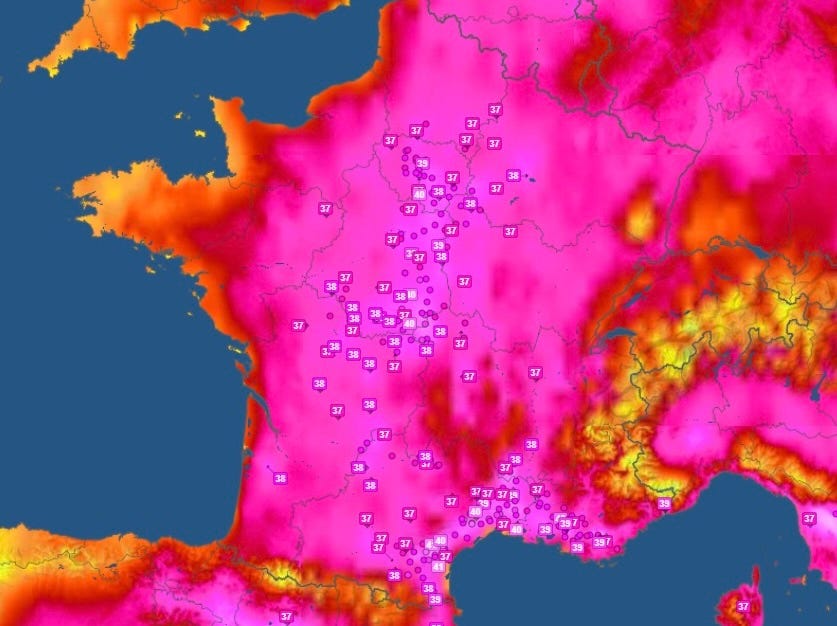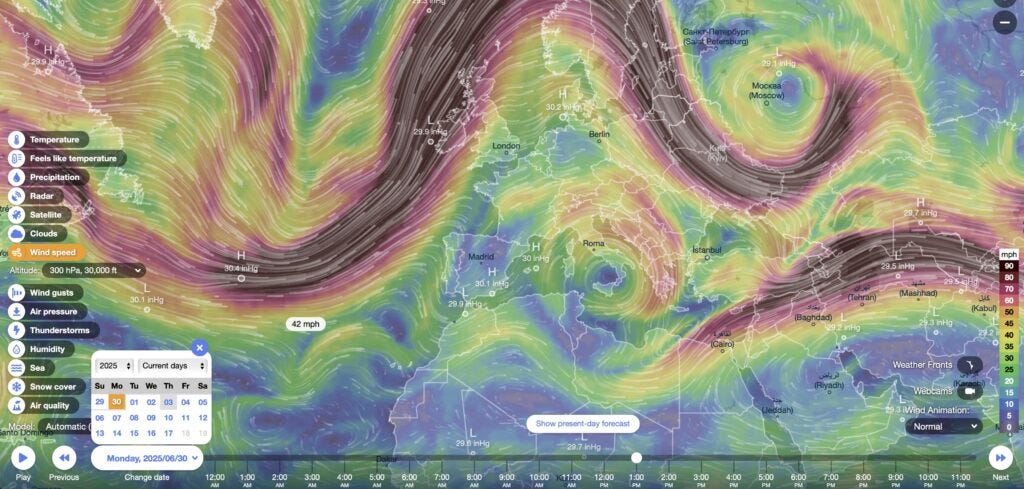Analysis of the extended heat wave in France – late June and early July 2025
The heatwave proved to be record breaking and had an impact across many regions of the country
The heatwave that swept France was notable for its early onset, intensity and national scale. A persistent anticyclonic “dome” drew very warm, dry air from the Maghreb into western Europe, producing prolonged daytime maximum temperatures frequently in the mid- to high 30s°C and local peaks around 40°C at the end of June. By mid July, Infoclimat confirmed that France had just experienced its hottest first part of the summer since records began. A national average temperature for the period of 1 June to 15 July was 22.37°C.
The average temperature was just ahead of the famous summer of 2003 when an average of 22.35°C was recorded for the same period. The third highest average of 21.77°C was experienced in 2023. The summer of 2003 was mainly marked by a historic heat wave during the first part of August with the average national temperature over the three months of the summer at 23.18°C.
The event was also geographically broad: at the end of June dozens of départements were placed on orange or red heat alerts, schools and public sites closed in affected cities, and the official heat-wave period peaked between 30 June and 1–2 July before easing in early July.
An Omega blocking pattern in which the jet stream forms a shape resembling the Greek letter “Ω”, characterized by a strong high-pressure ridge at its centre flanked by two low-pressure systems on either side was key in prolonging the extreme heat event. The pattern was a direct result of amplified Rossby waves, which shape the jet stream’s configuration with a pronounced northward ridge over western Europe, flanked by southward troughs over the eastern Atlantic and eastern Europe. The ridge trapped warm subtropical air from North Africa and the Mediterranean.
Position of the jet stream - 30 June 2025. Source: Ventusky
The highly anomalous temperatures of up to 6°C in the western Mediterranean contributed to the heat event by enhancing atmospheric heat and humidity.
Sea surface temperature anomaly - 23 June 2025 - Source - ClimateReanalyzer.org
A Climate Central analysis focused on the early part of the heat wave concluded that human-caused climate change made the extreme heat in France up to five times more likely, based on the Climate Shift Index (CSI). On going analysis of the index shows a figure of plus 4 and 5 for significant areas of the country.
Climate Shift Index 28 June - 2 July 2025 - Source Climate Central
An abiding feature of the heat wave is the broad geographic scope with records being broken across the country reflecting the heatwave’s unprecedented reach.
During the month of June, numerous French towns and cities broke temperature records, with Isobres Drôme (41.9°C) experiencing the highest recorded temperature on the final day of the month. In the south west of the country, the Aude Department, experienced abnormal heat with records being broken at Argeliers, near Narbonne - 41.6°C, Saint-Nazaire-d’Aude - 41°C with 39.9°C at Narbonne and 39.4°C in Carcasonne, a figure recorded earlier in the heat wave on 21 June.
Further east, Cadenet in the Vaucluse recorded 40.7°C on 28 June. While in the Ardeche, Grospierres on 29 June experienced a temperature of 40.9°C. Earlier in the extended heat wave on 13 June, Pruniers in the Indre department, the temperature reached 38.1°C, an exceptional level for central France. The north west of the country was not immune from the heat with Pommerit in the Côtes-d’Armor department of Brittany on 20 June recording a record temperature of 34.0°C. Early in the heat wave, the north east also experienced exceptional temperatures with a June record of 32.5°C in the Ardennes at Rocroi on 13 June. The capital itself also experienced near record heat with 40°C in 1 July, marking one of the hottest days for July on record since 1947.
The number of days with average maximum temperatures above 30°C reached 13 and in advance of the previous record of 9 days set in 2023. During the heatwave through June, 30 stations recorded temperatures exceeding 40°C.
Maximum Temperatures for 29 June 2025 - Source Meteo-villes
The peak of the heat wave occurred during the period 29 June through to the 2 July. Early analysis indicates 30 June 2025, was the hottest June day on record for France, with a national average high surpassing the previous record from 2019 approximately 27°C–30°C, driven by widespread maxima of 32°C–38°C and lows of 19°C–24°C.
High minimum temperatures throughout the heat wave was another important feature that heightened the likelihood of serious heat stress. Dawn lows of 25°C–29°C set likely June records for towns like Narbonne, Carcassonne, and Marseille and within the broader Mediterranean region. These warm nights, driven by record-hot sea temperatures, amplified the heatwave’s impacts. A collection of data is shown in the map below.
Minimum Temperatures for 1 July 2025 - Source Meteo-villes
The heat index, also known as the apparent temperature, is a measure of how hot it feels to the human body when relative humidity is combined with the air temperature. Although such data is difficult to ascertain for this particular heat wave on a macro scale, it is possible to calculate for certain locations and therefore provide an indication of the magnitude of the heat stress experienced. For instance, a temperature of 40°C with 50% humidity would yield a heat index of approximately 55°C, based on a standard calculation.
On Tuesday 1 July, Marseille recorded a temperature of 37°C at 18.00 hrs with a relative humidity of 57%. The heat index would therefore be 49.7°C. While on the same day and time in Carcassonne a combination of a temperature of 38°C and humidity of 36% produced a heat index of 41.7°C.
Further analysis of the impact of the extended heat wave will be required although it is recognised that the early-season timing increased health risks, as populations were less acclimatized. Two heat-related deaths and 300 hospitalizationswere reported , with vulnerable groups like the elderly and children most affected. With high humidity present in some regions, the level of heat stress was exacerbated contributing to conditions such as heatstroke and dehydration. As a precaution at the peak of the heat wave, nearly 1,900 schools were closed on the 1-2 July. In the same period Eiffel Tower’s upper floor was closed.
At the end of June, in the Aude Department, forest fires broke out in the southern Corbières mountain range leading to to evacuations and the closure of a motorway. It is understood that 400 hectares of land were affected. Further fires were experienced in the area with a fire affecting 2,000 hectares on 8 July near Narbonne. Although there has been a decline in the temperature in the area, there is still a heightened risk of further fires.
Yesterday, 9 July, over 1,000 firefighters battled a blaze in Marseille, France, which regional authorities reported was still not fully contained by late evening. Fuelled by strong winds and prolonged dry conditions, the fire consumed over 750 hectares, leading to the closure of Marseille airport, rail services, and motorways.
Approximately 400 people were evacuated as the fire approached the city, and 15,000 residents in northern Marseille, France’s second-largest city, were advised to stay indoors to avoid smoke. The blaze left 76 homes uninhabitable and damaged dozens more, according to the préfecture.
The heat wave of 2025 is likely to have significant impacts on the agricultural sector, particularly in specific regions of the country notably central and southern areas. A combination of heat stress and increasing drought conditions can impact crop yields and cause livestock issues with an increase in mortality rates and a reduction in productivity. The full impact will be quantified over time, but with research indicating that heatwaves are expected to both increase in frequency and duration , the need to develop new adaptation strategies including drought- resistant crops, improved irrigation practices, soil management and new infrastructure requirements will be paramount.







